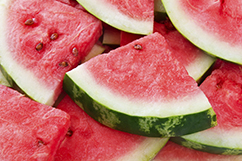Recently we asked you, our customers, which plants you have the most difficulty growing and which you would like some advice on planting. From the many replies two plants overwhelmingly stood out - coriander and watermelon.
In my opinion coriander is a must-have herb for any garden. It can be added to so many dishes - curries, salads, stir-fries etc - and the dried version just can't compare. But I do appreciate it can be a little tricky to grow as it's quite particular about the conditions it likes.
I wouldn't class watermelon as a must-have but it's a great-to-have plant and it's hard to beat a piece of the freshly-cut fruit straight from your own garden. But I'd also say it's even more particular about the conditions it likes than coriander.
So this month I'm going to go over getting the best out of your watermelon plants and click here for my top tips on cultivating coriander.
While I encourage everyone to give a crack at growing any plant they choose, watermelons require around three months of sun and heat averaging above 20 degrees Celsius. Unfortunately, not all areas of NZ are able to provide these conditions so be realistic about whether your garden can provide the heat required for successful watermelon fruit.
Watermelons grow across the ground like pumpkins so they need a bit of space but it's fine if they grow (otherwise known as trail) back across each other. What's important is finding a spot in your garden that has very free-draining soil. If your soil isn't free-draining you will need to mound it up to help create this effect.
Regardless of your type of soil, you'll need to dig in lots of compost and manure to deliver the nutrients the plants require to kick off. The flowers will require pollination to develop fruit, so it's great if you're able grow your watermelon near other plants, like lavender and salvia, which attract lots of bees. Before you plant cover the area in mulch like pea straw. This will help provide more nitrogen to the soil but also keep the fruit off the direct ground which will help prevent them rotting.
When you've found the perfect location for your plants simply pop each seedling in around 20-30cm apart.
The next important step to successful watermelon is keeping them well-fed. Feed them weekly with a nitrogen-based fertiliser until the flowers start to form and then use a high potassium fertiliser to encourage fruit. I often use tomato or strawberry fertilisers for this job as they focus on fruit and not leaf production. For those who aren't aware, nitrogen will encourage lots of leaf growth and potassium will bring on more fruit.
And the last vital step in producing great watermelons is in the name itself - water. This fresh, juicy fruit requires plenty of regular water. The trick is not overwatering which can rot the fruit and create perfect conditions for powdery mildew - especially if it's humid where you are. So, keep the soil moist but not boggy or too damp.
If you manage to pull off all the above, you should reap the results about three months after you plant. You can tell your fruit is ready to harvest when the stem where it joins the fruit is starting to soften and the leaves closest to the fruit die off. First the ones closest to the base of the plant will be ready, then those further out to the tips of the shoots will become ready. You'll probably also be able to smell a true watermelon smell.

